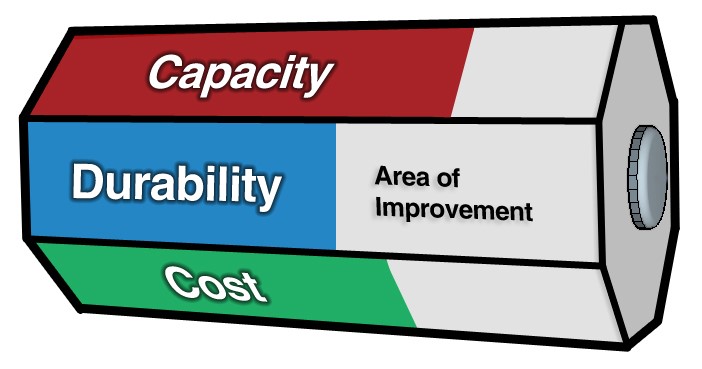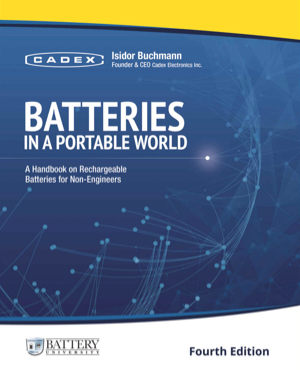A battery has some of the most stringent requirements and is on par with complex pharmaceutical products for which one change can have multiple side effects. To make a battery viable as an electric storage device, eight basic requirements must be met and a battery is fittingly called the octagon battery (Figure 1). The eight key elements to a working battery are as follows.

So-called because of the eight critical requirements needed to achieve basic function.
Many new arrivals claim to meet or exceed some prerequisites but fail in others, limiting market acceptance. Courtesy of Cadex
1. High specific energy
A key feature in consumer products is long runtime and device manufacturers achieve this by building batteries with high ampere-hour (Ah). The term lithium-ion is synonymous with a high specific energy. This does not mean that all Li-ion batteries have high Ah ratings. While the Energy Cell in an 18650 package can have 250 Ah/kg, the same chemistry in a Power Cell is 150 Ah/kg or less, and a long-life Li-ion for the powertrain is as low as 60 Ah/kg. Furthermore, consumer NiMH has about 90 Ah/kg compared to a 45 Ah/kg for long-life units in the electric powertrain, 45 Ah/kg being almost par with lead acid.
2. High specific power
Batteries made for power tools and electric powertrains provide high load capabilities but the specific energy is low.
3. Affordable price
Materials, refining processes, manufacturing, quality control and cell matching add cost for battery manufacturing; volume production only assists in part to reduce costs. Single cell use in mobile phones when no cell matching is required also lowers costs.
4. Long life
Nowhere is longevity more important than in large, expensive battery packs. If the battery life of the electric car could be extended from the anticipated 8–10 years to 20 years, driving an EV could be justified even if the initial investment is high. Longevity does not depend on battery design alone but also on how the battery is used. Adverse temperature, fast charge times and harsh discharge conditions stress the battery.
5. Safety
Lithium-based batteries can be built with high specific energy, but these systems are often reactive and unstable. Nickel-based Li-ion is such an example, so is metallic lithium. Most manufacturers stopped production of these systems because of safety issues. When used correctly, brand-name Li-ion is very safe.
6. Wide operating range
Batteries perform best at room temperature as cold temperatures slow the electrochemical reaction of all batteries. Li-ion cannot be charged below freezing, and heating blankets are often added to facilitate charging. High heat shortens battery life and compromises safety.
7. Toxicity
Cadmium- and mercury-based batteries have been replaced with alternative metals for environmental reasons. Authorities in Europe are attempting to ban lead acid, but no economical replacement of similar performance is available. Nickel- and lithium-based batteries contain little toxic material, but they still pose a hazard if disposed carelessly.
8. Fast charging
Lithium- and nickel-based batteries should be charged at 1C or slower (See BU-402: What Is C-Rate) At 1C, a nickel-based battery fully charges in about 90 minutes and Li-ion in 2–3 hours. Lead acid cannot be fast charged and the charge time is 8–16 hours. Fast charge times are possible for nickel and lithium, but the batteries must be built for it, be in good condition and be charged at room temperature. Aged and mismatched cells do not lend themselves to fast charging. Any charge above 1C causes undue stress, especially on the Energy Cell, and this should be avoided. (See BU-401a: Fast and Ultra-fast Chargers) NiCd is the only battery that accepts ultra-fast charge with minimal stress.
In addition to the eight basic requirements of the octagon battery, a battery must have low self-discharge to allow long storage and provide an instant start-up when needed. All batteries have self-discharge, and the loss increases with temperature and age. Secondary batteries have a higher self-discharge rate than the primary equivalent. A further requirement is a long shelf-life with little performance degradation. A battery is perishable, and like a food product, it is only good for a time. While alkaline batteries can be stored for 10 years and still provide 70 percent of their original energy, secondary batteries permanently lose capacity with age, even if not used. (See BU-702: How to store Batteries)

Comments
Looking for comments from the previous website?
Comments from the previous website are not compatible with our new commenting system but we have preserved them so our users can still reference and make use the information in them.
